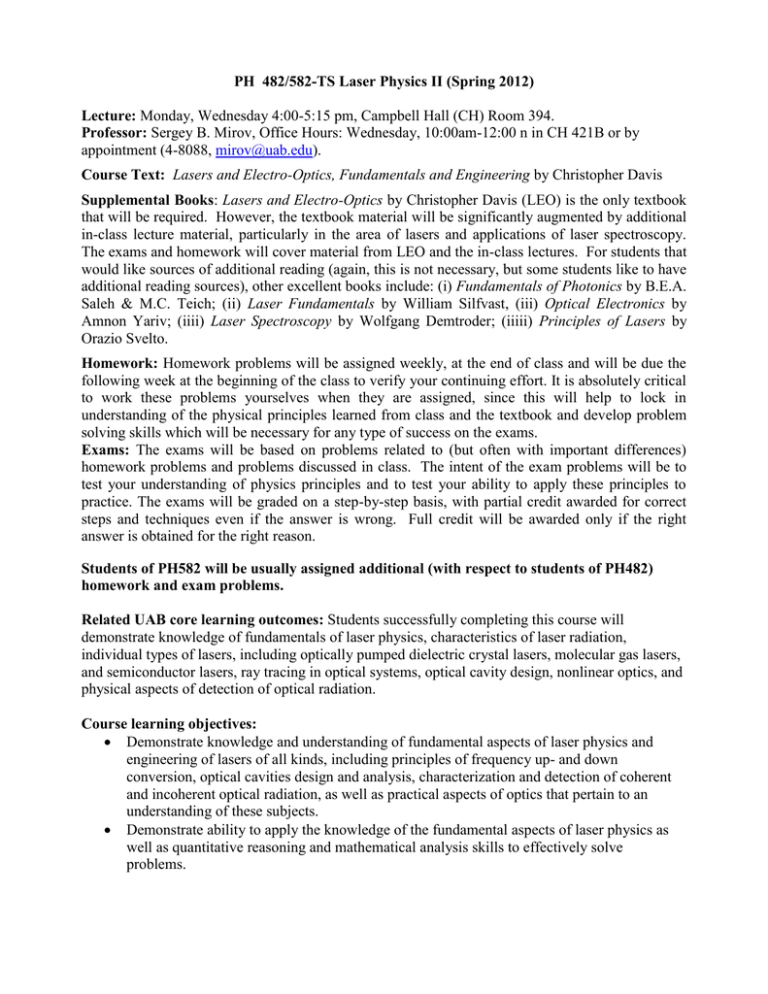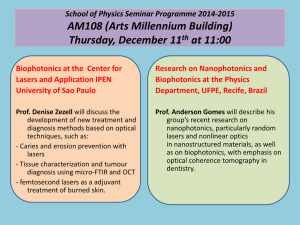PH 482/582-TS Laser Physics II (Spring 2012) Lecture: Monday
advertisement

PH 482/582-TS Laser Physics II (Spring 2012) Lecture: Monday, Wednesday 4:00-5:15 pm, Campbell Hall (CH) Room 394. Professor: Sergey B. Mirov, Office Hours: Wednesday, 10:00am-12:00 n in CH 421B or by appointment (4-8088, mirov@uab.edu). Course Text: Lasers and Electro-Optics, Fundamentals and Engineering by Christopher Davis Supplemental Books: Lasers and Electro-Optics by Christopher Davis (LEO) is the only textbook that will be required. However, the textbook material will be significantly augmented by additional in-class lecture material, particularly in the area of lasers and applications of laser spectroscopy. The exams and homework will cover material from LEO and the in-class lectures. For students that would like sources of additional reading (again, this is not necessary, but some students like to have additional reading sources), other excellent books include: (i) Fundamentals of Photonics by B.E.A. Saleh & M.C. Teich; (ii) Laser Fundamentals by William Silfvast, (iii) Optical Electronics by Amnon Yariv; (iiii) Laser Spectroscopy by Wolfgang Demtroder; (iiiii) Principles of Lasers by Orazio Svelto. Homework: Homework problems will be assigned weekly, at the end of class and will be due the following week at the beginning of the class to verify your continuing effort. It is absolutely critical to work these problems yourselves when they are assigned, since this will help to lock in understanding of the physical principles learned from class and the textbook and develop problem solving skills which will be necessary for any type of success on the exams. Exams: The exams will be based on problems related to (but often with important differences) homework problems and problems discussed in class. The intent of the exam problems will be to test your understanding of physics principles and to test your ability to apply these principles to practice. The exams will be graded on a step-by-step basis, with partial credit awarded for correct steps and techniques even if the answer is wrong. Full credit will be awarded only if the right answer is obtained for the right reason. Students of PH582 will be usually assigned additional (with respect to students of PH482) homework and exam problems. Related UAB core learning outcomes: Students successfully completing this course will demonstrate knowledge of fundamentals of laser physics, characteristics of laser radiation, individual types of lasers, including optically pumped dielectric crystal lasers, molecular gas lasers, and semiconductor lasers, ray tracing in optical systems, optical cavity design, nonlinear optics, and physical aspects of detection of optical radiation. Course learning objectives: Demonstrate knowledge and understanding of fundamental aspects of laser physics and engineering of lasers of all kinds, including principles of frequency up- and down conversion, optical cavities design and analysis, characterization and detection of coherent and incoherent optical radiation, as well as practical aspects of optics that pertain to an understanding of these subjects. Demonstrate ability to apply the knowledge of the fundamental aspects of laser physics as well as quantitative reasoning and mathematical analysis skills to effectively solve problems. Measurement of learning objectives: Homework problem sets and exams will be used regularly to measure understanding of the fundamental concepts presented as well as students’ abilities to apply this understanding to problems in laser physics. Both, problem sets and exams also provide an opportunity to evaluate the progression of students’ understanding of physical concepts and problem solving skills. Grading: Homework: Exam 1 (1h15m) Exam 2 (1h15m) Exam 3 (1h15m) Final Exam (2.5 hr) TOTAL: PH581 A: 90% or above B: 80%-89.9% C: 70%-79.9% D: 60%-69.9% F: 59.9% and below 25% 15% 15% 15% 30% 100% (250 pts) (150 pts) (150 pts) (150 pts) (300 pts) (1000 pts) PH481 A: 80% or above B: 70%-79.9% C: 60%-69.9% D: 50%-59.9% F: 49.9% and below Last day to withdraw from course with a “W” (Undergraduate only) is March 29, 2012 Your grades and other useful information are available at http://heisenberg.phy.uab.edu/~mirov/SMirov_Teaching_Page22.htm Tentative Schedule: # Date Text Topics 1 2 Jan 9 (Mo) Jan 11 (We) LEO Ch12.1-12.4, Class Lecture LEO Ch12.1-12.4, Class Lecture 3 Jan 16 (Mo) Jan 18 (Th) MLK Holiday LEO Ch12.1-12.4, Class Lecture 4 5 6 7 Jan 23 (Mo) Jan 25 (We) Jan 30 (Mo) Feb 1 (We) Class Lecture Class Lecture Exam 1 - Grades Ch 13.1-13.7 and class lecture 8 Feb 6 (Mo) Ch 13.1-13.7 and class lecture 9 10 11 12 13 14 Feb 8 (We) Feb 13 (Mo) Feb 15 (We) Feb 20 (Mo) Feb 22 (We) Feb 27 (Mo) 15 Feb 29 (We) 16 17 18 19 20 21 22 Mar 5 (Mo) Mar 7 (We) Mar 12 (Mo) Mar 14 (We) Mar 19 (Mo) Mar 21 (We) Mar 26(Mo) Mar 28 (We) April 2 (Mo) (Ch.13.8-13.12) (Ch.13.13-13.15) (Class Lecture, Ch.14) (Class Lecture or Ch.16.1-16.7) (Class Lecture or Ch.16.1-16.7) (Class Lecture or Ch.15 and Ch.16.8-16.14) (Class Lecture or Ch.15 and Ch.16.8-16.14) Ch.16.8-16.14) Exam 2 Grades (LEO Ch. 18) (LEO Ch. 18) Spring Break Spring Break (LEO Ch. 18) (LEO Ch. 20, 21) (LEO Ch. 21) Tunable Lasers, Organic Dye Lasers Tunable Solid State Lasers, Alexandrite & Ti-Sapph. Lasers, TM:II-VI Lasers(Class Lecture) No classes Tunable Solid State Lasers, Alexandrite & Ti-Sapph. Lasers, TM:II-VI Lasers(Class Lecture) Color Center Lasers Color Center Lasers Exam 1 over chapter 12 – Correct Solution Semiconductor Lasers, Semiconductor Physics Background Semiconductor Lasers, Semiconductor Physics Background Semiconductor Lasers Semiconductor Lasers Ray Tracing in an Optical System Gaussian Beams Gaussian Beams Optical Cavities 23 April 4 (We) (LEO Ch. 21) 24 April 9 (Mo) (LEO Ch. 19, 21) 25 April 11 (We) (LEO Ch. 19, 21) 26 27 28 29 30 31 April 16 (Mo) April 18 (We) April 23 (Mo) April 25 (We) April 30 (Tu) May 7 (Mo) (LEO Ch.22.1-22.8) (LEO Ch.22.6-22.8) (LEO Ch.22.6-22.8) Exam 3 Review for Final FINAL GRADES Optical Cavities Optical Cavities Exam 2 over chapters 13-16 Correct Solutions Optics of Anisotropic Media Optics of Anisotropic Media No classes No classes Optics of Anisotropic Media Wave Propagation in Nonlinear Media 2nd Harm. Generation. Up and Down-Conversion, Optical Parametr. Amplification 2nd Harm. Generation. Up and Down-Conversion, Optical Parametr. Amplification The Electro-Optics and Acousto-Optic Effects and Modulaton of Light Beams The Electro-Optics and Acousto-Optic Effects and Modulaton of Light Beams Detection of Optical Radiation Detection of Optical Radiation Detection of Optical Radiation Exam 3 over chapters 18-22 Correct Solutions Review for Final FINAL EXAM Over Chapters 12-22 and class notes 4:15-6:45pm CH 394


